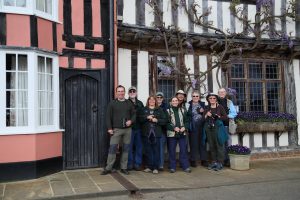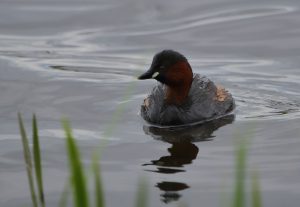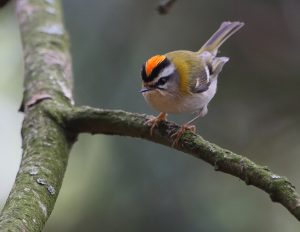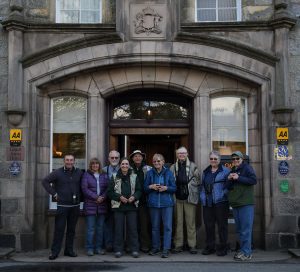Our ‘Grand Tour’ began at the Minsmere RSPB reserve where the feeders at the entrance allowed close views of Coal, Blue and Great Tits, as well as Greenfinch, Goldfinch and Chaffinches galore. Along the first trail through ancient Oak woods, the woodland birds were in good voice this morning, including Robin, Wren, Dunnock, Goldcrest, Blackcap, Treecreeper, Chiffchaff, Long-tailed Tit, and eventually, Marsh Tit. With news of a vagrant Savi’s Warbler at Island Mere, this was our target bird, which we soon pinpointed, singing in a small bush on the opposite side of the mere, while a pair of food-passing Marsh Harriers gave brilliant views right in front of the hide. A male Reed Bunting and a basking Common Lizard also showed well here, followed by Cetti’s Warbler and Whitethroat back on the trail.
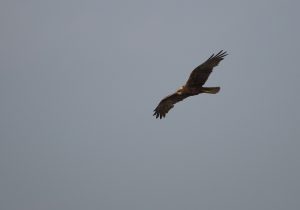
After lunch back at the Visitor Centre, we circuited the ‘scrapes’ which were teeming with birds including hundreds of Black-headed and Mediterranean Gulls and Sandwich Terns, as well as plenty of Shelduck and Avocets, along with rusty Bar-tailed and Black-tailed Godwits, plus Redshank, Greenshank, Barnacle and Greylag Geese, my first Swift of the year, and even a pair of smart ‘Tibetan’ Bar-headed Geese! In the dunes along the beach, we found one or two Stonechats and plenty of Linnets. Next, we moved on to nearby Westleton Heath for ‘Operation Dartford Warbler’ and soon found at least three of these handsome birds flitting between the low heather bushes, but without uttering a sound despite the sunny weather, although the wind probably dampened their spirits. Kestrel, Buzzard and Wheatear also showed here, making a grand total of 70 different birds seen by the end of the day, thanks to the variety of habitats here, including woodland, wetland, reedbeds, heathland and shingle shore.

Heading northwest from Saxmundham we began today with a visit to the picture postcard village of sunny Lavenham, a cluster of fifteenth century half-timbered houses, residing at a variety of crooked angles, with an imposing ‘new’ ‘wool church’ opened in 1525! The nearby Lackford Lakes nature reserve produced Egyptian Geese, Pochard, Sedge and Garden Warblers, Siskin, and a singing Nightingale, seen fleetingly, while remaining deep in the scrub for most of its rich serenade. Back at the Visitor Centre, a lucky few also saw a posing Kingfisher. Moving on to nearby Cavenham Heath, we found Red-legged and the much rarer Grey Partridge, plus plenty of Skylarks, singing their hearts out high in the blue sky, and an obliging pair of Woodlarks, foraging at very close range. Stonechats and Wheatears also showed well here but there were no signs of the usually present Stone Curlews (sorry folks). Next stop at the Lakenheath RSPB reserve, hoping for Bearded Tit, it was far too windy, but we did find a nice pair of Garganey.
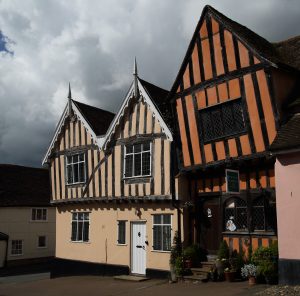
Today began with a Grey Wagtail feeding a short-tailed youngster at the edge of the River Wensum, right outside the hotel. Driving through picturesque Norfolk villages of neatly knapped flint houses, we arrived at the Cley Marshes reserve with storm Hannah in full swing, as her cold forty mile an hour wind swept across the marshes, keeping most of the songbirds quiet, apart from a Meadow Pipit and a Sedge Warbler with enough ‘balls’ to weather the storm and keep singing. From the shelter of the hides we spotted Wigeon, Ringed Plover, Dunlin and a single Ruff amongst all the Shelduck, Avocets and Black-tailed Godwits. Meanwhile, the chances of seeing our most wanted bird, the Bearded Tit, seemed ‘gone with the wind’, and yet with perseverance we not only saw a magnificent male, posing on an open ‘perch’, but actually managed to photograph this star bird; a remarkable achievement! The other highlight here was a Spoonbill actively feeding and showing off the sulphur-yellow neck and yellow tip to the spatulate bill. By now it felt like we had gone fifteen rounds in a boxing ring, thanks to the battering wind, so we returned to the welcome warm still air of the Visitor Centre for lunch, before heading west along the A149 coast road on the trail of a recently seen vagrant Purple Heron, but the windswept location was not conducive to a positive result, although Brent and Pink-footed Geese were both new for the trip here. Continuing west to the Titchwell Marshes RSPB reserve, teeming with hundreds of Black-headed Gulls, Avocets and Shelducks, Little Grebe was new for the trip, making a total of 104 species seen so far.
This morning we visited the Sandringham House estate, the Christmas retreat of Her Majesty the Queen, where the stunning little Firecrest was a car park bird! After lunch at the ‘Queen’s place’, a visit to the nearby Snettisham RSPB reserve produced a ‘warbler fest’ with good views of Blackcap, Chiffchaff, Common and Lesser Whitethroats, and best of all, the scarce Grasshopper Warbler, which has the amazing ability to produce a prolonged insect-like reeling ‘song’ from a perpetually static open beak, without stopping for breath! Other notable sightings here included hundreds of Grey Plovers, in their black-bellied breeding plumage, amongst thousands of waders out on the mud, as well as two soaring Red Kites, and a pair of ‘sky-dancing’ Marsh Harriers. Continuing our journey westward, we left Norfolk, via Cambridgeshire and Northamptonshire, arriving in Rutland, England’s smallest county, in time for dinner at the Old Pheasant in Glaston. By now the exotic looking Pheasant had become a daily sighting.
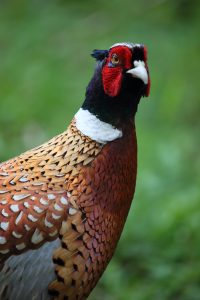
This morning, the weather had settled down, leaving a layer of mist in the vales as we headed to Lyddington, with its medieval Bishop’s palace, ancient church dedicated long ago to Saint Andrew, and quaint golden ironstone thatched cottages clustered around a picturesque village green, pink with cherry blossom. Nearby Rutland Water produced a list of 67 birds including a pair of Ospreys at their nest, along with plum views of Great Egret, Little Ringed Plover, Garden and Willow Warblers and Bullfinch, as well as a well hidden Nightingale, pinpointed by Elaine, while delighting us all with a prolonged and powerful serenade. Meanwhile, a vociferous Green Woodpecker would not ‘come out to play’.
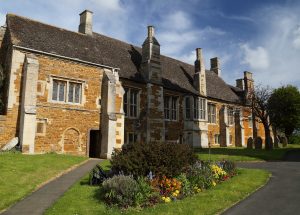
This morning we set off from Newark-on-Trent in Nottinghamshire, where the English civil war began in 1642, and drove north through ‘Robin Hood country’ into Yorkshire, England’s largest county, for a visit to the Potteric Carr nature reserve, where our main aim was to find the rare Black-necked Grebe. The reserve was alive with birdsong, including Wren, Blackcap, Chiffchaff and Whitethroat, plus Garden, Sedge and Willow Warblers, and although we saw both Little and Great Crested Grebes, the rarer Black-neck was a ‘no show’. Further north we called in at the Blacktoft Sands RSPB reserve, where Cetti’s and Reed Warblers were also heard, while notable sightings here included a female Goldeneye, a Buzzard, several Marsh Harriers, and plenty of Avocets, as well as Spotted Redshanks in smart charcoal-black breeding plumage and male Ruff, developing either black, ginger or rufous ruffs. After dinner at the Old Parsonage, just south of York, an outing for Tawny Owl unfortunately coincided with bell ringing practice in the adjacent church, and so a brief hearing of a distant Tawny Owl was drowned out by the bells! You just couldn’t make it up.
Today we headed east across Stamford Bridge, the site of a battle in 1066 where the Saxon king Harold Godwinson defeated Harald Hadrada, king of Norway. Journey’s end was the coast at the Bempton Cliffs RSPB reserve, with very close views of Tree Sparrows outside the Visitor Centre. Meanwhile, the cliffs were swarming with a quarter of a million seabirds! The spectacular scene was alive with Guillemots, Razorbills, Kittiwakes and gliding Gannets, and amongst the raucous throng were a few Puffins and Fulmars. Besides all these new birds, Rock and Stock Doves and Corn Bunting were also new for the trip. On the way back, we made time for a spot of sightseeing around the imposing York cathedral, founded in 637 AD, and towering to a height of 236 feet!
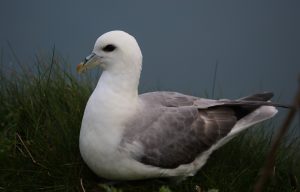
Driving west from the ‘white rose county’ of Yorkshire, across the Pennines into the ‘red rose county’ of Lancashire, a pleasant stroll alongside the burbling Pendle Water produced great views of a Dipper posing on a rock in mid stream. After a break for ‘elevenses’ back at the café here, we took one look at the monolithic Pendle Hill and chickened out of an ascent, given that the recently arrived Dotterel had not been reported for a couple of days. Continuing our journey in a north westerly direction, via the picturesque Forest of Bowland, we found several Grey and Pied Wagtails and Meadow Pipits along the Langden Valley, plus our first Common Sandpiper and Raven of the trip, but not a sniff of the target Ring Ouzel. Driving on through the Trough of Bowland, a short stop for Pied Flycatchers rewarded us with a great view of this smart little bird, with the added bonus of Mistle Thrush and House Martin, which were also both new. A little further along the road we also spotted our first Red Grouse of the trip. On the drive down from Bowland, the Irish Sea shimmered in the early evening sun, and we had now gone from east to west coasts in two days.
On the way to the Leighton Moss RSPB reserve, a brief visit to Warton Crag produced two well developed Raven chicks on a nest, and a Peregrine sitting on a nearby ledge, with a pink chest showing that it had recently had breakfast. At nearby Morecambe Bay, we enjoyed great views of a Grasshopper Warbler singing from an open perch, as well as plenty of Willow and Sedge Warblers. Our arrival at Leighton Moss, was greeted with several tame Robins, allowing arm’s length views, followed by a close view of a Nuthatch scolding a Tawny Owl sitting inside a nest box. With only a forehead and protruding tail visible inside the box, the owl was rated as a ‘fly by’ view! Meanwhile, a pair of Marsh Tits gave amazing views as they busily foraged for food right in front of us, totally oblivious to our presence. Eventually we also got to see and hear a Water Rail quickly scuttling back and forth alongside our path and we ended a very productive morning with scope views of a family of four Otters swimming and cavorting playfully together.
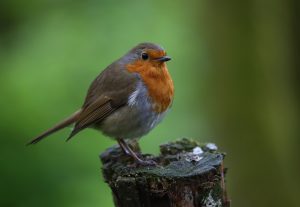
After lunch back at the Visitor Centre, it was time for ‘Operation Bearded Tit’, and along the causeway through the reeds we managed to pinpoint a pair of these elusive little birds. By now we had heard Reed Warblers in several locations during the trip and finally managed to spot a well hidden bird here, while a flock of newly arrived Swifts screamed overhead. Moving on into the beautiful North Pennines we enjoyed fabulous roadside views of several Red Grouse en route to our last hotel in England, next to the High Force waterfall in Teesdale.
It was a chilly -2°C at 5.30am this morning with a light dusting of snow on the windscreen as we set out to visit a Black Grouse lek. By 6am the action was in full swing as twenty impressive glossy navy blue Black Cocks, with inflated vivid red eye brows, squared up to each other while hissing, puffing themselves up and flapping their wings as they fought to attract the attentions of a handful of judging hens. After breakfast back at the hotel, a stroll down to the spectacular High Force waterfall, added Spotted Flycatcher to the trip list along with another Great Spotted Woodpecker. From here it was a scenic drive north through the desolate North Pennines and across the border into Scotland for the evening ferry from Oban across to the Isle of Mull, where Hooded Crow replaces the Carrion Crow.
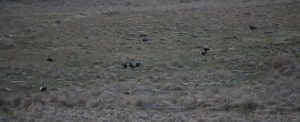
The forecast was fair but cold for our Treshnish Isle cruise. On the way to the departure point, a brief stop along the shore of Loch na Keal produced several new birds for the trip, starting with Rock Pipit on the rocky shore and a raft of Red-breasted Mergansers out on the loch, followed by a lovely singing Wood Warbler in the adjacent Oak woods and then the magnificent ‘flying barn door’ outline of a White-tailed Eagle, soaring above us. Further on, a Great Northern Diver (Common Loon) in full breeding plumage was next on the list, followed by Black Guillemot at the jetty. The first landing of the cruise was on Staffa, with its spectacular basalt columns, guarding the entrance to Fingal’s Cave. The target bird on Staffa was the Twite and eventually a few of us got lucky, while other sightings here included Whimbrel and Great Skua. Next stop was Lunga, where we ‘overdosed’ on Puffins as there were hundreds and hundreds of these loveable little auks literally waddling around our feet, providing a photographic feast. This fantastically spectacular little island, decorated with Primroses and Bluebells, also had thousands of Guillemots, as well as Razorbills, Kittiwakes, Fulmars and Shags, all at close range, creating a magical experience. On the return journey we also enjoyed views of Eiders, Grey Seals and another Great Skua
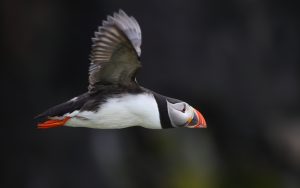
Our goal today was to see a Corncrake on Iona, but we were a little delayed en route by a photo-stop below Ben More with its light dusting of fresh snow, and by busier than normal traffic on the single track road, including ‘free range’ Highland cattle! Once ashore on Iona, it was eerily quiet, with not so much as a squeak from the usually vociferous Corncrakes, although we did find plenty of Wheatears, Meadow Pipits and a pair of Twite. Every likely looking patch of Corncrake habitat remained silent and so we dispersed for lunch, with free time to look around the Abbey, founded by Saint Columba in 563 AD. Meanwhile, I found a single calling crake, but only Bernie and Jude were around to hear the unmistakable rasping “crex crex” call, and yet the damn bird could not be seen amongst the dense bed of Yellow Irises, despite it being right ‘under our noses’. Back on Mull, we retraced the route along the Ross of Mull, but despite a sign warning of Otters for the next six miles, none were seen, although we did spot five Golden Plovers in their black-bellied breeding plumage in a roadside meadow. Back in the spectacular rugged scenery of Glen More, a brief stake out produced a ‘fly by’ view of a very distant Golden Eagle. Another birder here asked if we had seen any Whinchat, and ironically, the next bird we saw, a little further along the road, was a striking male Whinchat sitting on a roadside post! Further east, we took the “weak road” to Loch Spelve, where a Peacock, proudly displaying to his harem of Peahens, forced an emergency stop. Further on a planned stop in the Oak woods produced singing Tree Pipits and a calling Cuckoo, pinpointed in the scope, thanks once again to Eileen’s keen senses. Sadly, there was no sign of an Otter along the usually quiet shoreline of Loch Spelve, thanks to another ‘bell ringing moment’, this time caused by a group of camping sea kayakers. Just when it seemed that the show was over, and we were on our way back to the hotel for dinner, a Cuckoo posing on a roadside wire caused another emergency stop while the cameras went into overdrive. What a great way to end our time on ‘marvellous Mull’.
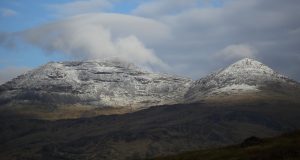
Back on the mainland we headed north on a scenic drive along the shore of Loch Linnhe to Fort William, in the shadow of snow-clad Ben Nevis, the highest point in the British Isles at 4406 feet above sea level, and then east along Glen Spean. Still in need of a Ring Ouzel, we followed the narrow winding road along spectacular Glen Roy, with numerous Meadow Pipits and the occasional Stonechat along the way. Eventually we got wind of our target ‘Mountain Blackbird’ when not one but two splendid males showed up, just like two buses at the same stop after a long wait with nothing! One male showed really well in the scope, sitting on a stone wall, while the other posed for photos further along the roadside. At last, a ‘lucky strike’ for the group. After a few more landscape shots on the return drive, and a ‘snap’ of a boulder bearing a plaque inscribed with “The centre of Scotland”, it began to rain, hastening our journey to the wonderful Grant Arms Hotel, our last base of the tour, in Grantown-on-Spey, home of Clan Grant since 1765.
It was particularly wintry this morning with a paltry 2°C outside the hotel, where the nearby Anagach woods soon produced nice views of Red Squirrels scurrying through the Caledonian Pine trees. Further north along the A939, a trio of Black Grouse were sparring half heartedly in the unspringlike weather. Moving on through a large colony of nesting Common Gulls, our target bird on the steel grey water of Lochindorb was the rare Black-throated Diver. Suddenly Elaine shouted “I’ve got a Loon!”, and there it was, popping up repeatedly in the scope. Red Grouse also showed well here right next to the road, while an Osprey feasted on a fish, said to be as long as a ‘fisherman’s tale’ according to a bystander. After lunch in Carrbridge, we headed north to the Moray Firth hoping to see the dolphins at Chanonry Point, where a steady stream of Common Terns and a Red-throated Diver passed by. Although the information board proclaimed this to be “one of the best places in the world to see Bottle-nosed Dolphins”, none were forthcoming! Presumably, the miserable weather was too cold and wet for the dolphins!
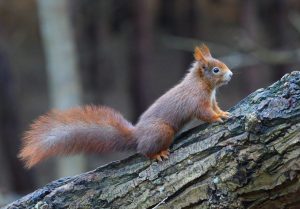
After dinner we headed south for the Speyside Wildlife hide near Loch an Eilein on the Rothiemurchus estate. As the daylight faded and the floodlights came on, the stage was set for camera action. Right on cue two sleek Pine Martens entered the scene, scurrying up and down branches with the agility of squirrels. Around 10.30pm a family group of four Badgers appeared, snuffling up peanuts and raisins with the efficiency of Hoovers, although one of them showed a particular preference for the raisins. Time passed quickly as the Badgers foraged ‘bold as brass’ right outside the hide windows, giving face to face views! What a magical experience.
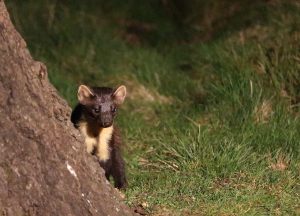
It was actually sunny this morning, although at a meager 4°C it was still as cold as a fridge! First stop was at Avielochan, where the annually present Slavonian Grebes were actually there and showing really well, unlike the bygone Stone Curlews, Corncrakes, Otters and Dolphins! A passing Sparrowhawk also put in an appearance here. Moving on to the nearby beautifully tranquil Abernethy Forest, we soon got close views of perky little Crested Tits, along with Goldeneye and Red-throated Diver on Loch Garten, while, a couple of lively male Redstarts caused a time consuming ‘merry dance’ until everyone managed to catch a decent view of one. This afternoon we visited the Loch Garten RSPB reserve, with its famous Osprey nest, which was sadly empty for the first time in sixty years! However, Red Squirrel, Great Spotted Woodpecker and singing Tree Pipits showed well here.
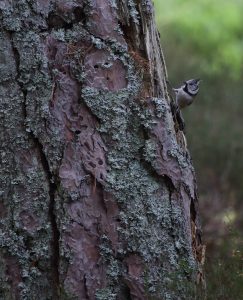
By now we had driven 1496 miles, through a variety of beautiful landscapes from the Suffolk coast to the Cairngorms, while staying at nine excellent hotels, eating sixteen first class dinners, walking around 90 miles and seeing 163 bird species including, in order of appearance, a diversity of stars like Marsh Tit, Savi’s Warbler, Marsh Harrier, Cetti’s Warbler, Avocet, Mediterranean Gull, Sandwich Tern, Bar-headed Goose, Kittiwake, Stonechat, Dartford Warbler, Wheatear, Garden Warbler, Siskin, Nightingale, Kingfisher, Grey Partridge, Woodlark, Garganey, Grey Wagtail, Ruff, Bearded Tit, Spoonbill, Brent and Pink-footed Geese, Firecrest, Lesser Whitethroat, Grasshopper Warbler, Grey Plover, Red Kite, Osprey, Great Egret, Little Ringed Plover, Bullfinch, Goldeneye, Spotted Redshank, Puffin, Guillemot, Razorbill, Gannet, Fulmar, Rock and Stock Doves, Corn Bunting, Dipper, Raven, Pied Flycatcher, Red Grouse, Peregrine, Nuthatch, Water Rail, Black Grouse, Spotted Flycatcher, Hooded Crow, Rock Pipit, Red-breasted Merganser, Wood Warbler, White-tailed Eagle, Great Northern Diver, Black Guillemot, Twite, Whimbrel, Great Skua, Eider, Golden Plover, Whinchat, Cuckoo, Ring Ouzel, Black-throated Diver, Slavonian Grebe, Crested Tit and Redstart, as well as enjoying fantastic views of Badger and Pine Marten, plus Brown Hare, Red Squirrel, Red and Roe Deer, and Grey and Harbour Seals.

